 Back in June, we examined the macroeconomic forecasts of the three agencies, the IMF, the OECD and the European Commission, all of which publish forecasts every six months. The IMF has recently published its latest World Economic Outlook (WEO) and its accompanying database. Unlike the April WEO, which, given the huge uncertainty surrounding the pandemic and its economic effects, only forecast as far as 2021, the latest version forecasts as far ahead as 2025.
Back in June, we examined the macroeconomic forecasts of the three agencies, the IMF, the OECD and the European Commission, all of which publish forecasts every six months. The IMF has recently published its latest World Economic Outlook (WEO) and its accompanying database. Unlike the April WEO, which, given the huge uncertainty surrounding the pandemic and its economic effects, only forecast as far as 2021, the latest version forecasts as far ahead as 2025.
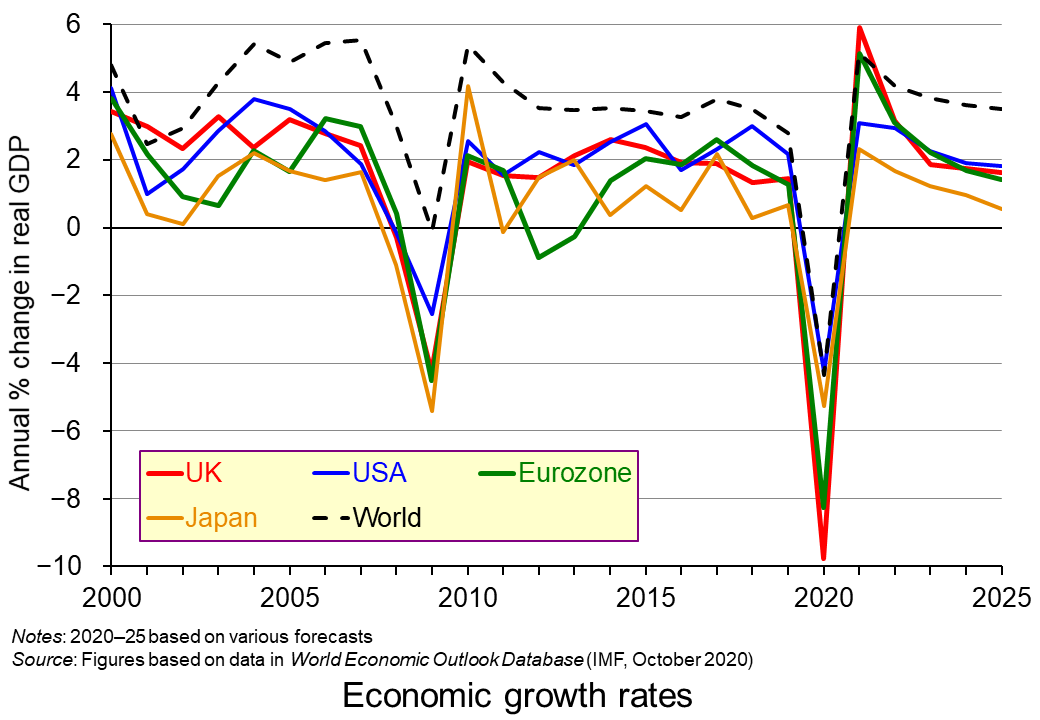 In essence the picture is similar to that painted in April. The IMF predicts a large-scale fall in GDP and rise in unemployment, government borrowing and government debt for 2020 (compared with 2019) across virtually all countries.
In essence the picture is similar to that painted in April. The IMF predicts a large-scale fall in GDP and rise in unemployment, government borrowing and government debt for 2020 (compared with 2019) across virtually all countries.
World real GDP is predicted to fall by 4.4%. For many countries the fall will be much steeper. In the UK, GDP is predicted to fall by 9.8%; in the eurozone, by 8.3%; in India, by 10.3%; in Italy, by 10.8%; in Spain, by 12.8%. 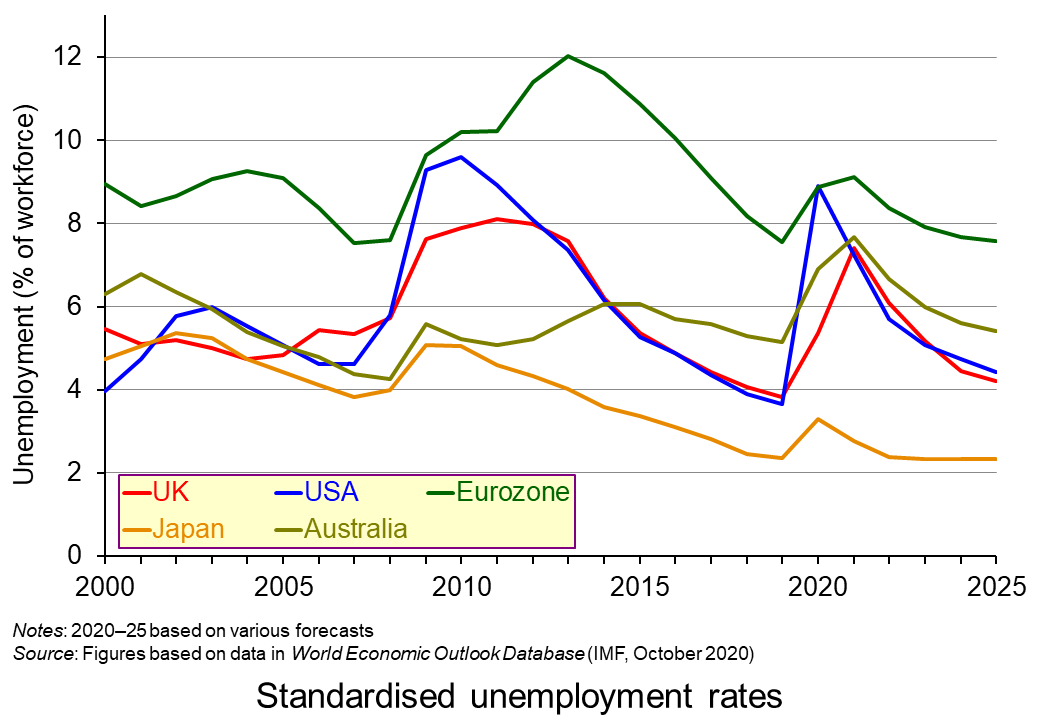 There will then be somewhat of a ‘bounce back’ in GDP in 2021, but not to the levels of 2019. World real GDP is predicted to rise by 5.2% in 2021. (Click here for a PowerPoint of the growth chart.)
There will then be somewhat of a ‘bounce back’ in GDP in 2021, but not to the levels of 2019. World real GDP is predicted to rise by 5.2% in 2021. (Click here for a PowerPoint of the growth chart.)
Unemployment will peak in some countries in 2020 and in others in 2021 depending on the speed of recovery from recession and the mobility of labour. (Click here for a PowerPoint of the unemployment chart.)
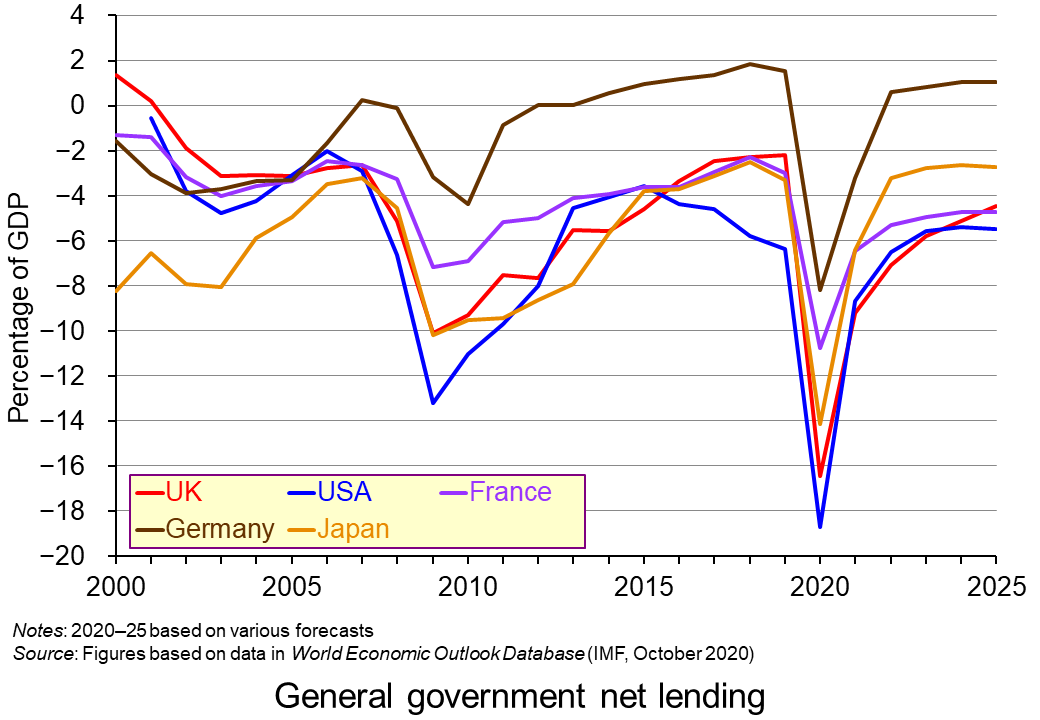 Inflation is set to fall from already low levels. Several countries are expected to see falling prices.
Inflation is set to fall from already low levels. Several countries are expected to see falling prices.
Government deficits (negative net lending) will be sharply higher in 2020 as a result of government measures to support workers and firms affected by lockdowns and falling demand. Governments will also receive reduced tax revenues. (Click here for a PowerPoint of the general government net lending chart.)
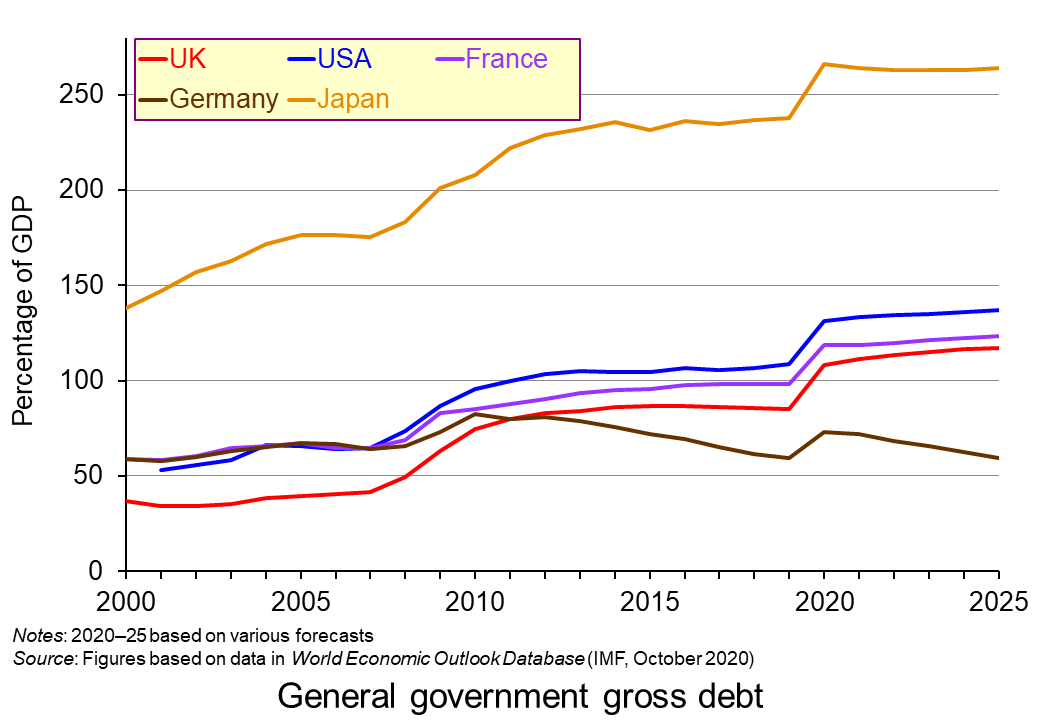 Government debt will consequently rise more rapidly. Deficits are predicted to fall in 2021 as economies recover and hence the rise in debt will slow down or in some cases, such as Germany, even fall. (Click here for a PowerPoint of the general government gross debt chart.)
Government debt will consequently rise more rapidly. Deficits are predicted to fall in 2021 as economies recover and hence the rise in debt will slow down or in some cases, such as Germany, even fall. (Click here for a PowerPoint of the general government gross debt chart.)
After the rebound in 2021, global growth is then expected to slow to around 3.5% by 2025. This compares with an average of 3.8% from 2000 to 2019. Growth of advanced economies is expected to slow to 1.7%. It averaged 1.9% from 2000 to 2019. For emerging market and developing countries it is expected to slow to 4.7% from an average of 5.7% from 2000 to 2019. These figures suggest some longer-term scarring effects from the pandemic.
Uncertainties
 In the short term, the greatest uncertainty concerns the extent of the second wave, the measures put in place to contain the spread of the virus and the compensation provided by governments to businesses and workers. The WEO report was prepared when the second wave was only just beginning. It could well be that countries will experience a deeper recession in 2000 and into 2021 than predicted by the IMF.
In the short term, the greatest uncertainty concerns the extent of the second wave, the measures put in place to contain the spread of the virus and the compensation provided by governments to businesses and workers. The WEO report was prepared when the second wave was only just beginning. It could well be that countries will experience a deeper recession in 2000 and into 2021 than predicted by the IMF.
This is recognised in the forecast.
The persistence of the shock remains uncertain and relates to factors inherently difficult to predict, including the path of the pandemic, the adjustment costs it imposes on the economy, the effectiveness of the economic policy response, and the evolution of financial sentiment.
With some businesses forced to close, others operating at reduced capacity because of social distancing in the workplace and with dampened demand, many countries may find output falling again. The extent will to a large extent depend on the levels of government support.
In the medium term, it is assumed that there will be a vaccine and that economies can begin functioning normally again. However, the report does recognise the long-term scarring effects caused by low levels of investment, deskilling and demotivation of the parts of the workforce, loss of capacity and disruptions to various supply chains.
The deep downturn this year will damage supply potential to varying degrees across economies. The impact will depend on various factors … including the extent of firm closures, exit of discouraged workers from the labour force, and resource mismatches (sectoral, occupational and geographic).
 One of the greatest uncertainties in the medium term concerns the stance of fiscal and monetary policies. Will governments continue to run large deficits to support demand or will they attempt to reduce deficits by raising taxes and/or reducing benefits and/or cutting government current or capital expenditure?
One of the greatest uncertainties in the medium term concerns the stance of fiscal and monetary policies. Will governments continue to run large deficits to support demand or will they attempt to reduce deficits by raising taxes and/or reducing benefits and/or cutting government current or capital expenditure?
Will central banks continue with large-scale quantitative easing and ultra-low or even negative interest rates? Will they use novel forms of monetary policy, such as directly funding government deficits with new money or providing money directly to citizens through a ‘helicopter’ scheme (see the 2016 blog, New UK monetary policy measures – somewhat short of the kitchen sink)?
Forecasting at the current time is fraught with uncertainty. However, reports such as the WEO are useful in identifying the various factors influencing the economy and how seriously they may impact on variables such as growth, unemployment and government deficits.
Report, speeches and data
- World Economic Outlook, October 2020: A Long and Difficult Ascent
IMF, Report (October 2020)
- World Economic Outlook Databases
IMF (October 2020)
- “We Must Take the Right Actions Now!”—Opening Remarks for Annual Meetings Press Conference
IMF, Speech, Kristalina Georgieva, IMF Managing Director (14/10/20)
 Press Briefing: World Economic Outlook
Press Briefing: World Economic OutlookIMF, Gita Gopinath, Chief Economist and Director of the Research Department, IMF; Gian Maria Milesi-Ferretti, Deputy Director, Research Department, IMF; Malhar Shyam Nabar, Division Chief, Research Department, IMF; Moderator: Raphael Anspach, Senior Communications officer, Communications Department, IMF (13/10/20)
Articles
Questions
- Explain what is meant by ‘scarring effects’. Identify various ways in which the pandemic is likely to affect aggregate supply over the longer term.
- Consider the arguments for and against governments continuing to run large budget deficits over the next few years.
- What are the arguments for and against using ‘helicopter money’ in the current circumstances?
- On purely economic grounds, what are the arguments for imposing much stricter lockdowns when Covid-19 rates are rising rapidly?
- Chose two countries other than the UK, one industrialised and one developing. Consider what policies they are pursuing to achieve an optimal balance between limiting the spread of the virus and protecting the economy.
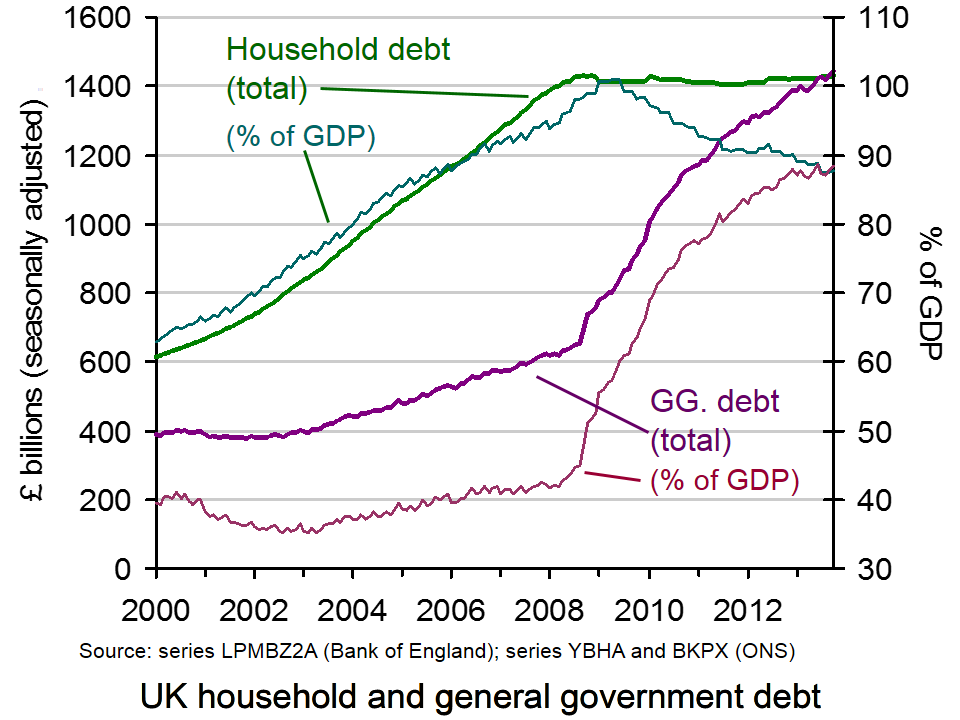 Household debt in the UK has reached a record level. Individuals now owe £1430 billion. This compares with the UK’s general government debt of £1443 billion – also at a record level. These figures are illustrated in the chart (click here for a PowerPoint).
Household debt in the UK has reached a record level. Individuals now owe £1430 billion. This compares with the UK’s general government debt of £1443 billion – also at a record level. These figures are illustrated in the chart (click here for a PowerPoint).
But these figures are nominal. If you look at the real figures (i.e. corrected for inflation), household debt has been falling. In today’s prices, household debt peaked at £1668 billion in March 2008. Also, if you look at household debt as a proportion of GDP, it fell from a peak of 100.96% in May 2009 to 87.43% in July 2013 (see chart). However, since then it has begun rising again, standing at 87.65% in October 2013.
So has household debt become less of a problem? In aggregate terms, the answer is probably yes. However, it is too early to know whether a continuing recovery in the economy will be fuelled by real debt rising again and whether the recovery will encourage people to take on higher levels of debt?
For many people, however, debt has become more and more of a problem. In other words, the aggregate figures conceal what has happened in terms of the distribution of debt. According to a Centre for Social Justice (CSJ) study:
Indebted households in the poorest 10 per cent of the country have average debts more than four times their annual income. Average debt repayments within this group amounted to nearly half their gross monthly income.

And the poorest families, often with very poor credit ratings, are frequently forced to turn to payday lenders, charging sky-high interest rates (see Capping interest rates on payday loans: a government U-turn?).
As mainstream banks reduced access to credit following the financial crash, the market for short-term high-cost credit (payday lenders, pawnbrokers, rent-to-buy and doorstop lenders) increased dramatically and is now worth £4.8 billion a year.
Payday lenders have increased business from £900 million in 2008/09 to just over £2 billion (or around 8 million loans) in 2011/12. Around half of payday loan customers reported taking out the money because it was the only form of credit they could get. The number of people going to loan sharks is also said to have increased – the most recent estimate puts it at 310,000 people.
With rising energy and food bills hitting the poorest hardest, this section of the population could find debt levels continuing to rise, especially if interest rates rise. As Chris Pond, who chaired the CJS study, stated:
The costs to those affected, in stress and mental disorders, relationship breakdown and hardship is immense. But so too is the cost to the nation, measured in lost employment and productivity and in an increased burden on public services.
Articles
£1,430,000,000,000 (that’s £1.43 trillion): Britain’s personal debt timebomb Independent, Andrew Grice (20/11/13)
Average household debt ‘doubled in last decade’ The Telegraph, Edward Malnick (20/11/13)
UK household debt hits record high BBC News (29/11/13)
UK debt crisis: poorest face ‘perfect storm’ Channel 4 News (20/11/13)
One in five struggle with serious debt The Telegraph, Nicole Blackmore (27/11/13)
It doesn’t matter what we do with Wonga: personal debt is about to rocket The Telegraph, Tim Wigmore (26/11/13)
Poorest families ‘need more help over debt’ BBC News (20/11/13)
Report
More than 5,000 people a year ‘homeless’ as household debt crisis deepens, CSJ warns Centre for Social Justice Press Release (20/11/13)
Data
Monthly amounts outstanding of total (excluding the Student Loans Company) sterling net lending to individuals and housing associations (in sterling millions) seasonally adjusted Bank of England
Public Sector Finances First Release – Public Sector Consolidated Gross Debt ONS
Household debt (Economics Indicators update) House of Commons Library (29/11/13)
Questions
- What are the macroeconomic implications of rising levels of household debt?
- Why may an economy which has high levels of household debt be more subject to cyclical fluctuations in real GDP?
- What are the problems of having a recovery driven largely by increased consumer expenditure?
- Why have many people in the poorest sectors of society found their debt levels rising the fastest?
- Why may rising levels of debt of the most vulnerable people make it harder for the Bank of England to use conventional monetary policy if recovery becomes established?
- What policies could be pursued to try to reduce the debts of the poorest people?
- Discuss the effectiveness of these various policies.
National debt has increased rapidly over the past few years. In 2006/7 general government debt was £577.8bn or 42.9% of GDP. In 2009/10 it was £1000.4bn or 71.3% of GDP. It is set to go higher, with government debt forecast to be around 87% of GDP in 2011. This compares with forecasts of 82% for Germany, 87% for France, 103% for the USA, 134% for Greece and 195% for Japan.
Getting the deficit and debt down has, not surprisingly, become an issue in many countries. In the UK it has become the major current pre-occupation of the Coalition government and on 20 October it is set to announce major public spending cuts as a means of achieving this.
To get a flavour of the government’s thinking and the message that ministers are putting out to the electorate, the following are quotes from the Prime Minister’s and then the Chancellor’s speeches to the Conservative Party Conference:
This year, we’re going to spend £43 billion pounds on debt interest payments alone. £43 billion – not to pay off the debt – just to stand still. Do you know what we could do with that sort of money? We could take eleven million people out of paying income tax altogether. We could take every business in the country out of corporation tax. That’s why we have acted decisively – to stop pouring so much of your hard-earned money down the drain. We are already paying £120m of interest every single day thanks to the last Labour government. (David Cameron)
It’s the borrowing that doesn’t go away as the economy grows, and we have £109bn of it. It’s like with a credit card. The longer you leave it, the worse it gets. You pay more interest. You pay interest on the interest. You pay interest on the interest on the interest. We are already paying £120m of interest every single day thanks to the last Labour government. Millions of pounds every day that goes to the foreign governments we owe so they can build the schools and hospitals for their own citizens that we aren’t able to afford for ours. How dare Labour call that protecting the poor? (George Osborne)
Let’s unpick this a bit. Who earns the interest? The answer is that it is paid to holders of government debt in the form of government bonds (gilts), national savings certificates, premium bonds, etc. In other words it is paid to savers, whether individuals or pension funds or companies.
Does it all go abroad? In fact 29% of gilts are held abroad. The rest are held by British residents. Thus some 70% of the interest rate paid on government debt goes to British residents and supports pensions and savers. It can thus be seen as a transfer from taxpayers to savers.
Because of the record low interest rates many pensioners who rely on savings interest have seen their incomes fall dramatically. Others draw income from a ‘self-invested personal pension’. The amount that can be drawn each year is based on tables according to a person’s age and the current 15-year Treasury gilt yield (currently 3.45%). Thus the lower the rate of interest, and the less the yield, the less that can be drawn.
So who are the gainers and losers from high general government debt and attempts to get it down? Read the following articles and look at the data and then try answering the questions.
Articles
Britons have donated £7m to help pay off the national debt (but that’s a drop in the ocean) Mail Online, Daniel Martin (9/10/10)
A trillion and rising: Britain’s £1,000,000,000,000 debt means it is now paying as much in interest as it does for defence Mail Online, Hugo Duncan (1/10/10)
Spending cuts “not enough”, say small firms Telegraph, James Hurley (8/10/10)
UK public finances post record August deficit Guardian, Julia Kollewe (21/9/10)
Another paradox of thrift The Economist, Buttonwood (16/9/10)
Data
The gilt market UK Debt Management Office
Gilt market data UK Debt Management Office
Overseas gilt holdings UK Debt Management Office
Public sector: current position ONS (30/9/10)
Public sector finances ONS Statistical Bulletin (21/9/10)
Government deficit and debt under the Maastricht Treaty ONS Statistical Bulletin (30/9/10)
Contributions to the government deficit and debt ONS Statistical Bulletin (31/3/10)
Questions
- Explain the difference between central government, general government and public-sector deficits and debt.
- Who loses from a rising public-sector debt? Who gains?
- Conduct an international comparison of (a) the level of the government deficit and debt and (b) their rate of growth over the past few years.
- What is meant by the ‘yield’ on a particular gilt?
- If gilt yields fall, does this mean that the government pays less on existing gilts? Is it likely to pay less on new gilt issues? Explain.
- How do cuts affect the distribution between savers and borrowers?
In the past few days, the euro has been under immense speculative pressure. The trigger for this has been the growing concern about whether Greece would be able to force through austerity measures and cut its huge deficit and debt. Also there has been the concern that much of Greece’s debt is in the form of relatively short-term bonds, many of which are coming up for maturity and thus have to be replaced by new bonds. For example, on 19 May, Greece needs to repay €8.5 billion of maturing bonds. But with Greek bonds having been given a ‘junk’ status by one of the three global rating agencies, Standard and Poor’s, Greece would find it difficult to raise the finance and would have to pay very high interest on bonds it did manage to sell – all of which would compound the problem of the deficit.
Also there have been deep concerns about a possible domino effect. If Greece’s debt is perceived to be unsustainable at 13.5% of GDP (in 2009), then speculators are likely to turn their attention to other countries in the eurozone with large deficits: countries such as Portugal (9.4%), Ireland (14.3%) and Spain (11.2%). With such worries, people were asking whether the euro would survive without massive international support, both from within and outside the eurozone. At the beginning of 2010, the euro was trading at $1.444. By 7 May, it was trading at $1.265, a depreciation of 12.4% (see the Bank of England’s Statistical Interactive Database – interest & exchange rates data
If the euro were in trouble, then shock waves would go around the world. Worries about such contagion have already been seen in plummeting stock markets. Between 16 April and 7 May, the FTSE100 index in London fell from 5834 to 5045 (a fall of 13.5%). In New York, the Dow Jones index fell by 8.6% over the same period and in Tokyo, the Nikkei fell by 7.6%. By 5 May, these declines were gathering pace as worries mounted.
Crisis talks took place over the weekend of the 8/9 May between European finance ministers and, to the surprise of many, a major package of measures was announced. This involves setting aside €750bn to support the eurozone. The package had two major elements: (a) €60bn from EU funds (to which all 27 EU countries contribute) to be used for loans to eurozone countries in trouble; (b) a European Financial Stabilisation Mechanism (a ‘Special Purpose Vehicle (SPV)’), which would be funded partly by eurozone countries which would provide €440bn and partly by the IMF which would provide a further €250bn. The SPV would be used to give loans or loan guarantees to eurozone countries, such as Greece, which were having difficulty in raising finance because of worries by investors. The effect would also be to support the euro through a return of confidence in the single currency.
In addition to these measures, the European Central Bank announced that it would embark on a ‘Securities Markets Programme’ involving the purchase of government bonds issued by eurozone countries in difficulties. According to the ECB, it would be used to:
.. conduct interventions in the euro area public and private debt securities markets to ensure depth and liquidity in those market segments which are dysfunctional. The objective of this programme is to address the malfunctioning of securities markets and restore an appropriate monetary policy transmission mechanism.
Does this amount to quantitative easing, as conducted by the US Federal Reserve Bank and the Bank of England? The intention is that it would not do so, as the ECB would remove liquidity from other areas of the market to balance the increased liquidity provided to countries in difficulties. This would be achived by selling securities of stronger eurozone countries, such as Germany and France.
In order to sterilise the impact of the above interventions, specific operations will be conducted to re-absorb the liquidity injected through the Securities Markets Programme. This will ensure that the monetary policy stance will not be affected.
So will the measures solve the problems? Or are they merely a means of buying time while the much tougher problem is addressed: that of getting deficits down?
Webcasts and podcasts
 Rescue plan bolsters the euro BBC News, Gavin Hewitt (10/5/10)
Rescue plan bolsters the euro BBC News, Gavin Hewitt (10/5/10)
 The EU rescue plan explained Financial Times, Chris Giles, Emily Cadman, Helen Warrell and Steve Bernard (10/5/10)
The EU rescue plan explained Financial Times, Chris Giles, Emily Cadman, Helen Warrell and Steve Bernard (10/5/10)
 Peston: ‘Crisis is not over’ BBC Today Programme (10/5/10)
Peston: ‘Crisis is not over’ BBC Today Programme (10/5/10)
 Greece ‘will get into even more deep water’ BBC Today Programme (11/5/10)
Greece ‘will get into even more deep water’ BBC Today Programme (11/5/10)
Articles
EU ministers offer 750bn-euro plan to support currency (including video) BBC News (10/5/10)
EU sets up crisis fund to protect euro from market ‘wolves’ Independent, Vanessa Mock (10/5/10)
Euro strikes back with biggest gamble in its 11-year history Guardian, Ian Traynor (10/5/10)
Debt crisis: £645bn rescue package for euro reassures markets … for now Guardian, Ian Traynor (10/5/10)
The E.U.’s $950 Billion Rescue: Just the Beginning Time, Leo Cendrowicz (10/5/10)
Eurozone bail-out (portal) Financial Times
Bailout does not address Europe’s deep-rooted woes: Experts moneycontrol.com (11/5/10)
An ever-closer Union? BBC News blogs: Stephanomics, Stephanie Flanders (10/5/10)
Eurozone crisis is ‘postponed’ BBC News blogs: Peston’s Picks, Robert Peston (10/5/10)
Multi-billion euro rescue buys time but no solution BBC News, Lucy Hooker (11/5/10)
No going back The Economist (13/5/10)
It is not Greece that worries EURO: It is China that teeters on a collapse Investing Contrarian, Shaily (11/5/10)
Data and official sources
For deficit and debt data see sections 16.3 and 18.1 in:
Ameco Online European Commision, Economic and Financial Affairs DG
For the ECB statement see:
10 May 2010 – ECB decides on measures to address severe tensions in financial markets ECB Press Release
Questions
- Why should the measures announced by the European finance ministers help to support the euro in the short term?
- Why should the ECB’s Securities Markets Programme not result in quantitative easing?
- Explain what is meant by sterlisation in the context of open market operations.
- What will determine whether the measures are a long-term success?
- Explain why there may be a moral hazard in coming to the rescue of ailing economies in the eurozone. How might such a moral hazard be minimised?
- Why should concerns about Greece lead to stock market declines around the world?
- What is the significance of China in the current context?
This podcast is from the BBC’s Today Programme on Radio 4. With government debt set to rise from around 45 per cent in 2007 to around 85 per cent by 2010, is there a danger that the UK might find it difficult, or even impossible, to fund the debt through the necessary issuing of bonds and other government securities? In the podcast, Richard Portes, Professor of Economics at London Business School, and Gerard Lyons, Chief Economist at Standard Chartered Bank, discuss the question.
 Could the UK default on its debt? BBC Today Programme (20/8/09)
Could the UK default on its debt? BBC Today Programme (20/8/09)
For data on general government debt in OECD countries, see OECD Economic Outlook No. 85 Annex Tables 62 and 32. See also tables 27 to 30 for data on general government deficits.
See also:
Public sector borrowing soaring BBC News (20/8/09)
Public sector finances, July 2009 ONS (20/8/09)
Questions
- Compare the UK’s general government debt with that of other major countries. Consider both the level of debt and its changes in the past three years and projected changes over the next two years.
- Why, according to Professor Portes, is there virtually no chance that the UK will default on its debt?
- What is the most likely route by which the level of debt will be reduced over the coming few years?
- What are the implications for long-term interest rates if the UK government debt remains at high levels?
 Back in June, we examined the macroeconomic forecasts of the three agencies, the IMF, the OECD and the European Commission, all of which publish forecasts every six months. The IMF has recently published its latest World Economic Outlook (WEO) and its accompanying database. Unlike the April WEO, which, given the huge uncertainty surrounding the pandemic and its economic effects, only forecast as far as 2021, the latest version forecasts as far ahead as 2025.
Back in June, we examined the macroeconomic forecasts of the three agencies, the IMF, the OECD and the European Commission, all of which publish forecasts every six months. The IMF has recently published its latest World Economic Outlook (WEO) and its accompanying database. Unlike the April WEO, which, given the huge uncertainty surrounding the pandemic and its economic effects, only forecast as far as 2021, the latest version forecasts as far ahead as 2025. In essence the picture is similar to that painted in April. The IMF predicts a large-scale fall in GDP and rise in unemployment, government borrowing and government debt for 2020 (compared with 2019) across virtually all countries.
In essence the picture is similar to that painted in April. The IMF predicts a large-scale fall in GDP and rise in unemployment, government borrowing and government debt for 2020 (compared with 2019) across virtually all countries.  There will then be somewhat of a ‘bounce back’ in GDP in 2021, but not to the levels of 2019. World real GDP is predicted to rise by 5.2% in 2021. (Click here for a PowerPoint of the growth chart.)
There will then be somewhat of a ‘bounce back’ in GDP in 2021, but not to the levels of 2019. World real GDP is predicted to rise by 5.2% in 2021. (Click here for a PowerPoint of the growth chart.) Inflation is set to fall from already low levels. Several countries are expected to see falling prices.
Inflation is set to fall from already low levels. Several countries are expected to see falling prices.  Government debt will consequently rise more rapidly. Deficits are predicted to fall in 2021 as economies recover and hence the rise in debt will slow down or in some cases, such as Germany, even fall. (Click here for a PowerPoint of the general government gross debt chart.)
Government debt will consequently rise more rapidly. Deficits are predicted to fall in 2021 as economies recover and hence the rise in debt will slow down or in some cases, such as Germany, even fall. (Click here for a PowerPoint of the general government gross debt chart.) In the short term, the greatest uncertainty concerns the extent of the second wave, the measures put in place to contain the spread of the virus and the compensation provided by governments to businesses and workers. The WEO report was prepared when the second wave was only just beginning. It could well be that countries will experience a deeper recession in 2000 and into 2021 than predicted by the IMF.
In the short term, the greatest uncertainty concerns the extent of the second wave, the measures put in place to contain the spread of the virus and the compensation provided by governments to businesses and workers. The WEO report was prepared when the second wave was only just beginning. It could well be that countries will experience a deeper recession in 2000 and into 2021 than predicted by the IMF. One of the greatest uncertainties in the medium term concerns the stance of fiscal and monetary policies. Will governments continue to run large deficits to support demand or will they attempt to reduce deficits by raising taxes and/or reducing benefits and/or cutting government current or capital expenditure?
One of the greatest uncertainties in the medium term concerns the stance of fiscal and monetary policies. Will governments continue to run large deficits to support demand or will they attempt to reduce deficits by raising taxes and/or reducing benefits and/or cutting government current or capital expenditure?  Press Briefing: World Economic Outlook
Press Briefing: World Economic Outlook
